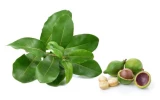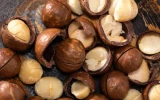How to Start a Macadamia Nut Farm From Scratch
The global market for macadamia nuts was worth around $1.32 billion in 2021 and is growing due to their popularity. However, macadamia trees take about 7-10 years to fully mature, so it's a long-term investment that requires careful planning and patience. In this article, we'll give a full guide on how you can get started with macadamia cultivation even without prior experience.
Starting a macadamia nut farm involves selecting a suitable location with the right climate and soil conditions, acquiring quality macadamia seedlings or grafts, and implementing effective irrigation and pest control methods. It will also entail knowing how to properly space the plants for optimal growth.
While macadamia trees take a few years to start producing nuts, with proper care, they can become a profitable and sustainable agricultural venture. As you read further, you'll also learn the right time to prune your trees, how to deal with non-fruiting macadamia trees, and the pollination requirements of macadamia trees.
Summary
- Macadamia trees flourish best in tropical or subtropical climates, so choose a location free from frost and have access to full sun and well-draining soil with a pH between 5.5 and 6.5.
- When selecting cultivars, note that only Macadamia integrifolia and Macadamia tetraphylla produce edible nuts, with hybrid varieties such as Beaumont, offering additional benefits like frost tolerance and disease resistance.
- Macadamia trees should be spaced 15-20 feet apart for optimal growth, coupled with consistent irrigation, balanced fertilization, and mulching.
- Macadamia trees take several years to start producing nuts, with grafted trees bearing fruit in 4-6 years and seed-grown trees in 7-10 years, so long-term financial planning with consideration to the maturation year is a must to avoid loss.
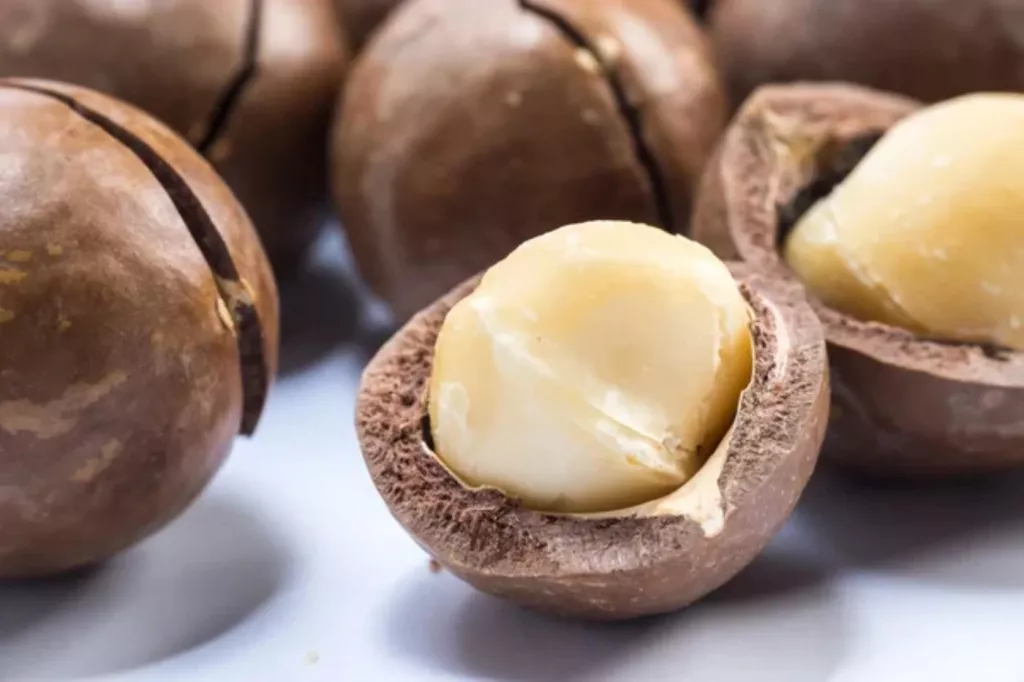
On this page:
The table below provides a concise overview of the various aspects of macadamia tree cultivation:
| Feature | Detail |
|---|---|
| Origin | Australia |
| Lifespan | Over 40 years |
| Climate requirement | Tropical/subtropical, 60-100°F temperature |
| Growing zone | USDA Hardiness zones 9-11 |
| Soil preferences | Well-draining, slightly acidic (pH 5.5-6.5) |
| Recommended spacing | 15-20 feet between trees |
| Density per acre | 109-194 trees per acre |
| Density per hectare | 278-484 trees per hectare |
| Sun exposure requirements | Full sun, 6-8 hours per day |
| Edible species | Macadamia integrifolia, Macadamia tetraphylla |
| Popular varieties | Beaumont, 344, 660, 741, 816, etc. |
| Common pests and diseases | Macadamia nut borer, rats, bats, phytophthora, anthracnose, nut fall |
| Growth rate | 1-2 feet per year |
| Time to fruit production | Grafted: 4-6 years, Seed-grown: 7-10 years |
| Flowering and harvesting | Spring/early summer; Annually when nuts fall |
| Estimated tree price range | Young trees: $20-30, Mature trees: $150-200 |
| Average nut yield | Young trees: 0-20 lbs, Mature trees: 50-150 lbs |
| Tree value based on age | Young: $0-100, Mature: $100-600, Old: $600-1000 |
| Pruning time | Late winter/early spring |
| Common pollinators | Bees (especially honeybees) as effective pollinators |
Understanding the Macadamia Nuts
Before delving into macadamia farming, you need to get acquainted with the basic characteristics of macadamia nuts and the trees they come from.
Origin of macadamia trees
Macadamia trees are valued for their hard-shelled, nutritious nuts. Originating in Australia, these subtropical trees are now cultivated in various regions around the world. Macadamia nuts are known for their rich, buttery taste and are a source of beneficial fats.
Macadamia tree lifespan
Macadamia trees can take several years to begin bearing fruit, with maximum yields usually reached at around 10 years of age. With proper care, a single tree can live and produce nuts for over 40 years, making this a long-term investment in your farming future.
Choosing the Right Location
The right environment will ensure healthy growth and optimal macadamia nut production. Let's focus on the specific aspects that make a location ideal for your macadamia trees.
Macadamia tree climate requirements
You'll want to find a location with a tropical or subtropical climate. These climates provide the warm temperatures and appropriate humidity levels that macadamia trees need. You can find a more complete discussion of the climate required for macadamia cultivation in this article.
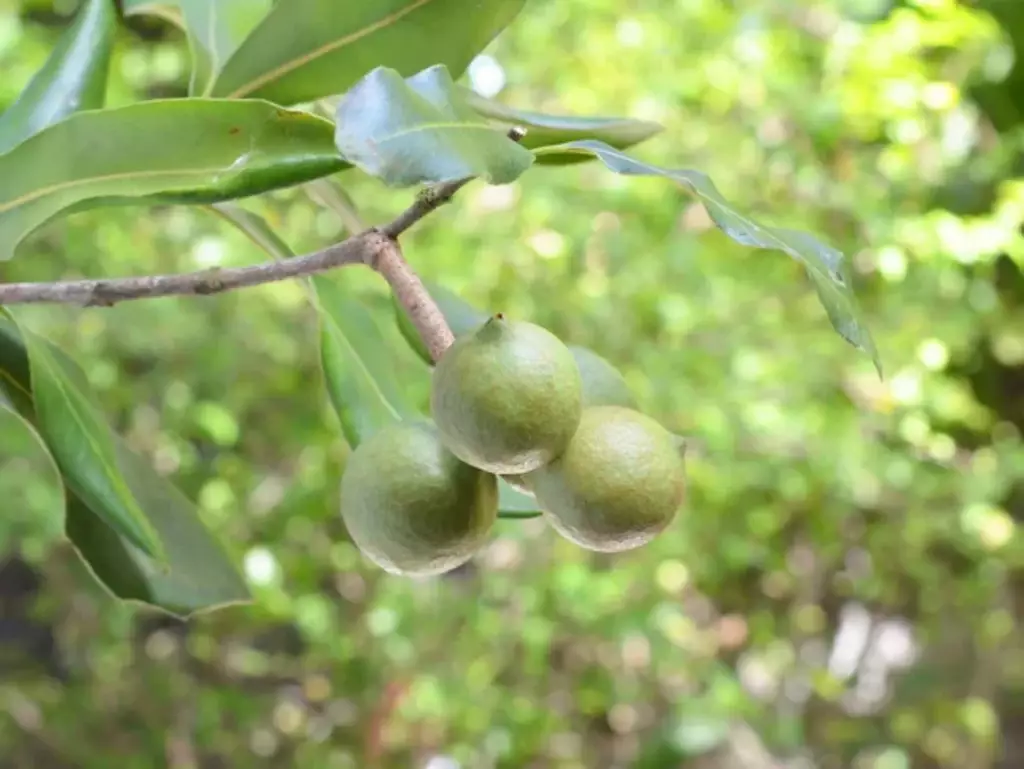
Avoid frost-prone areas
When selecting a site for your farm, make sure the area is free from frost and freeze. Macadamia trees are sensitive to cold weather and will likely be damaged under freezing temperatures.
Choose areas within USDA hardiness zones 9 -11
Macadamia nut trees flourish in USDA Hardiness Zones 9 to 11. These regions are known for their mild to warm weather conditions, perfectly suited for growing macadamias.
You can try growing macadamias in Victoria
While Victoria's climate is not the most ideal for macadamia trees, with careful management and adaptation of growing conditions, successful cultivation is possible. Find out here how you can grow macadamia trees in Victoria.
Macadamia trees can thrive in the sunshine state of Florida
Macadamia trees can thrive in Florida, especially in the southern and central regions. These areas, falling in USDA hardiness zones 10–11, offer a warm, subtropical climate that closely resembles the native habitat of macadamia trees, with mild winters and long, hot summers.
You can check out this article for a list of the best varieties of macadamia grown in Florida.
Land preparation
Choose land that isn't too rough or difficult to manage. Clear the land of any debris or competing vegetation before planting.
The land will need to be accessible for machinery and provide enough room for the trees to receive full sun which is vital for their growth. When choosing the best spot for your macadamia farm in a certain region, you can turn to this article for more tips.
Soil preferences of macadamia trees
Your macadamia trees will need well-draining soil to prevent root rot. The ideal soil pH for macadamia is [between 5.5 and 6.5. If necessary, amend your soil to reach this pH range. Remember, soil health is as important as the location itself.
Aside from slightly acidic soil pH, macadamias also prefer sandy loam or loamy soil. Learn more about the type of soil required for macadamia trees to thrive in this article.
Selecting Cultivars
Not all macadamia varieties will thrive in the same conditions. You'll need to select cultivars that suit your chosen location.
The best macadamia variety
The Beaumont variety is one of the most popular macadamia varieties due to its suitability to various growing conditions and climates, making it a versatile choice for growers in different parts of the world.

Here's a reference to a more detailed comparison of the best macadamia varieties you might want to consider other than Beaumont.
Types of macadamia trees
When choosing the type of macadamia tree to cultivate, one thing to keep in mind is that not all of them are edible.
Only Macadamia integrifolia and Macadamia tetraphylla are edible and widely consumed due to their nutritional value, rich flavor, and versatility in culinary applications.
To maximize production and adapt to different environmental conditions, hybrid varieties of M. integrifolia and M. tetraphylla are combined to produce desirable traits such as frost tolerance, disease resistance, and nut quality.
They are tailored to suit specific growing conditions and market demands, making them a popular choice for many commercial growers. To help you identify the different macadamia species, here's a visual guide that might make it easier.
Planting and Growing Macadamias
Starting a macadamia nut farm is a commitment to nurturing trees that could potentially bear fruit for decades. Selecting quality saplings, understanding the planting process, and maintaining proper watering and nutrient levels are crucial to your success.
Propagating macadamia trees
One thing to consider when growing macadamia nut trees is to choose the right propagation technique in order to succeed. In this section, we'll discuss various methods for propagating macadamia trees, each with its own requirements and success rates.
How to grow a macadamia tree from a nut
- Involves a germination test (discarding nuts that float in water) and planting the remaining nuts in well-draining soil.
- Requires regular watering and warmth, and sprouts appear within a few weeks.
- The success rate is moderate.
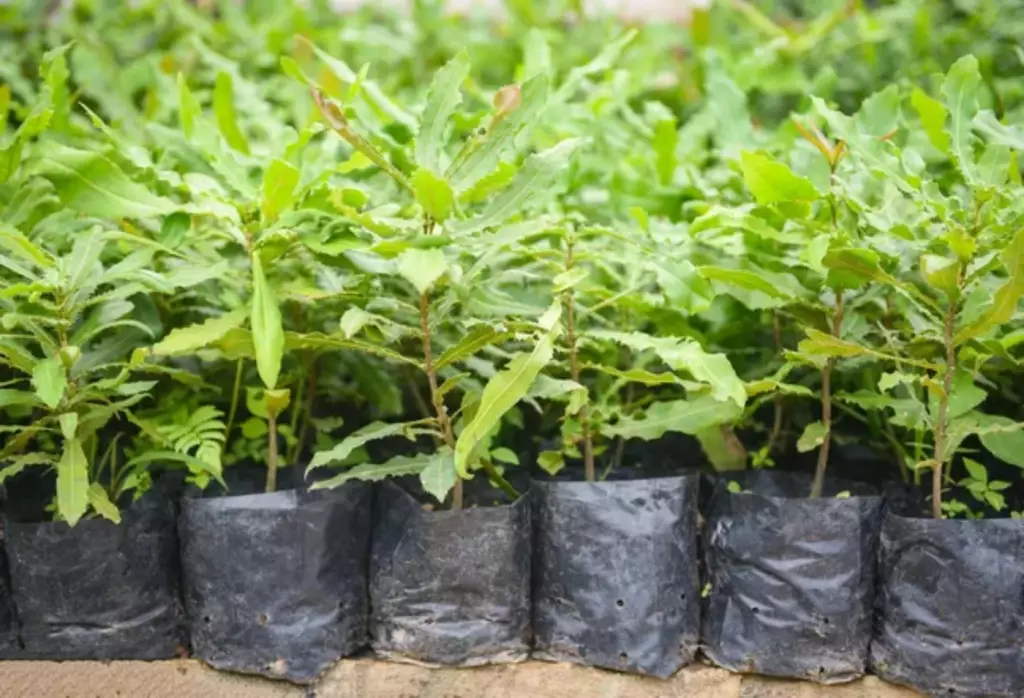
Growing macadamia trees in pots
- Suitable for regions not ideal for outdoor cultivation
- Requires using large pots with good drainage and a well-draining potting mix.
- Has a moderate success rate.
Can macadamia be grown from cuttings?
Macadamia trees are typically propagated through grafting or seed, as these methods are more reliable. However, propagation from cuttings, while less common, can be attempted under the right conditions
To begin, you'll need healthy macadamia saplings or cuttings. While saplings are commonly used, cuttings can also be rooted to create a new tree. Make sure that the young trees or cuttings are sourced from reputable nurseries with a history of strong, disease-free plants.
Planting procedures
When it's time to plant your saplings, choose a location with well-draining soil and a pH of 5.0 to 6.5. Macadamias prefer full sun, requiring at least 6-8 hours of direct sunlight daily.
Plant the trees in holes twice as wide as the root ball but just as deep, ensuring that the soil level matches the previous soil mark on the sapling.
Macadamia tree spacing
It's recommended to maintain a distance of 15 to 20 feet between each macadamia tree. This spacing is crucial for proper sunlight penetration and air circulation, which are vital for the trees' growth and nut production.
For larger orchards, spacing rows 25 to 30 feet apart can allow for vehicle access.
Macadamia trees per acre
The recommended spacing for macadamia generally ranges from 15 to 20 feet between trees. If macadamia trees are spaced 15 feet apart, about 194 trees can be planted per acre.
However, spacing them 20 feet apart reduces the number to approximately 109 trees per acre. The density per acre also varies depending on the variety of macadamia trees.
How many macadamia trees per hectare
Planting 278 to 484 macadamia trees per hectare is recommended.
This density is based on a spacing of 15 to 20 feet between trees, ensuring adequate sunlight and air circulation for each tree, which is vital for their development and nut production
Irrigation and watering
After planting, establish a consistent irrigation routine to keep the soil moist but not waterlogged. In the beginning stages, water your saplings deeply once per week, adjusting based on rainfall and temperature.
Overwatering can lead to root issues, so ensure your soil's moisture content is well managed.
Fertilization strategy
Fertilize your macadamias with a balanced N-P-K (nitrogen-phosphorus-potassium) fertilizer. In the early growth stages, emphasize nitrogen to support foliage and root development.
As your trees mature, adjust the fertilizer composition to promote flowering and fruit set while avoiding an excess of nitrogen, which can reduce yield.
Mulching and soil health
Mulching helps retain soil moisture, regulate temperature, and reduce weed competition. Use organic mulch such as wood chips or grass clippings, keeping it away from the tree trunk to prevent rot.
Regularly check and adjust the soil pH if necessary to ensure it remains between 5.0 and 6.5, which is ideal for macadamia trees.
Managing Pests and Diseases
In starting your macadamia nut farm, you must pay attention to the various pests and diseases that can affect your crop. Recognizing the signs and taking early action is key to ensuring the health and productivity of your macadamia nut trees.
Pests and diseases make macadamia cultivation challenging
Macadamias may be difficult to grow because they are susceptible to a number of diseases. Your trees may be susceptible to attacks by pests such as the macadamia nut borer and fruit spotting bug.
Familiarize yourself with the specific damage they cause - the macadamia nut borer, for instance, will penetrate the nut, whereas the fruit spotting bug can cause premature nut drop.

Preventative strategies
Prevent pests and diseases by choosing the right cultivar for your region and ensuring careful cultural practices. Use resistant varieties when possible and maintain a cleaning routine to remove fallen nuts and debris that could harbor pests.
Production, Harvesting and Post-Harvest
Macadamia tree growth and fruit production
Beginning your journey into macadamia nut farming reaches a crucial phase when your trees bear fruit. n.
Are macadamia trees fast-growing?
Macadamia trees are not considered fast-growing. They typically grow at a moderate rate of about 1–2 feet per year.
This growth rate can vary depending on the specific variety of macadamia trees, as well as environmental conditions and care practices. Therefore, compared to some other tree species, macadamia trees grow relatively slowly.
This article can give you more insights into the growth rate of macadamias and the factors that affect it.
How long until macadamia trees bear fruit
Macadamia trees grown from seed typically take 7 to 10 years to fruit, while grafted trees, which are a combination of a mature cutting and a rootstock, can start producing in 4 to 6 years.
Once the trees start bearing, the nuts take about 5 to 6 months to ripen after pollination.
How often do macadamia trees fruit
Macadamia integrifolia and Macadamia ternifolia are species of macadamia that typically produce fruit on an annual basis.
On the other hand, Macadamia tetraphylla and Macadamia jansenii follow a biennial fruiting pattern. This biennial cycle of fruit production is likely an evolutionary adaptation aimed at optimizing resource allocation and ensuring a reliable supply for seed development and dispersal.
Aside from the species-specific fruiting patterns, macadamias also exhibit regional variations in fruit production.
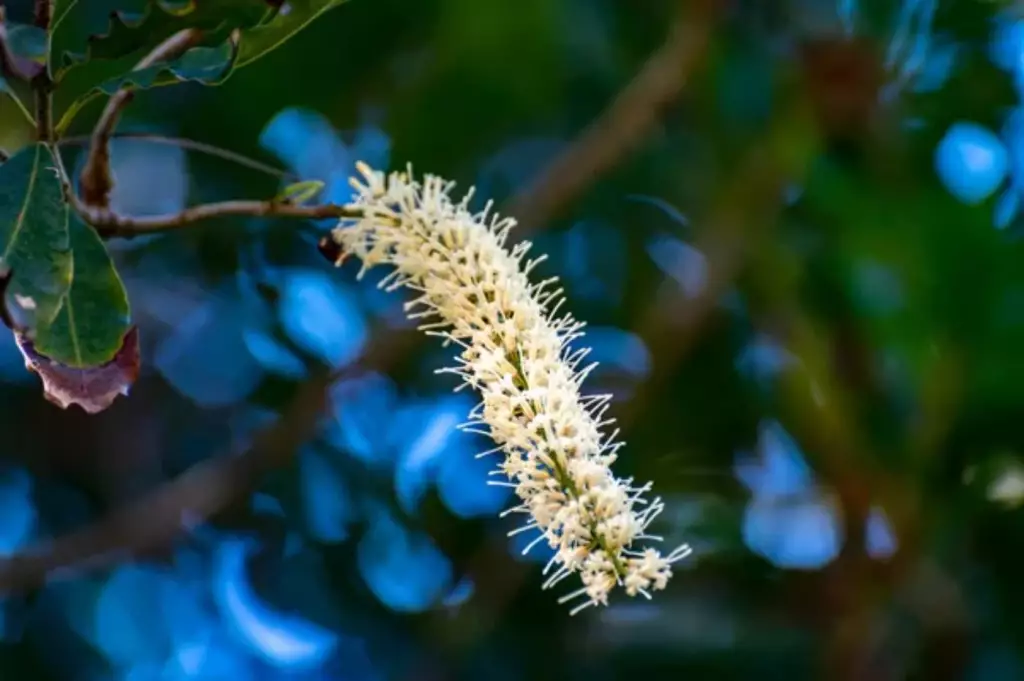
When do macadamia trees flower
Macadamia trees typically flower in spring and early summer, although the exact timing can vary depending on the geographical location and local climate conditions.
In the Northern Hemisphere, this usually means flowering occurs around April to June, while in the Southern Hemisphere, it's around October to December.
Harvesting techniques
Macadamia nuts are typically ready for harvest when they naturally fall to the ground, indicating they are ripe. Other indications of ripeness and readiness for harvest can be found here.
To collect these ripe nuts, some labor is required, either by hand or with mechanical harvesters. If you opt for hand harvesting, be prepared to gather your nuts every two to four weeks, especially during wet weather. This reduces the risk of mold or animal damage.
How often are macadamia trees harvested?
Macadamia trees, known for producing luxurious and rich-tasting macadamia nuts, are typically harvested once a year. However, in some regions with favorable conditions, macadamia trees might produce nuts that can be harvested twice a year.
Processing macadamia nuts
Once harvested, the processing of macadamia nuts begins with the removal of husks. This should happen quickly—within 24 hours—to prevent spoilage.
The kernels inside need to be handled with care since they are the valuable part. Commercial processors use a series of machines to crack, grade, and sort the nuts, but on a smaller scale, you might use hand-operated tools.
Drying and storage
Proper drying and storage are vital to keep macadamia nuts in top condition. Drying reduces moisture content, which helps to extend shelf life.
Spread the nuts in a single layer in a cool, dry place, making sure they have adequate air circulation. For storage, keep them in airtight containers away from direct sunlight and heat to maintain their quality.
Learning The Economics of Macadamia Farming
Price, Value, and Yield Per Macadamia Tree
| Age | Price Range | Nut Yield per Tree (lbs) |
|---|---|---|
| Young | $20 - $30 | 0 - 20 |
| Mature | $150 to 200 | 50 - 150 |
Macadamia tree price
The price of a macadamia tree can vary depending on factors such as age and size. Young macadamia trees (about 1-10 feet tall) have an estimated price between $20 and $30. This is because they have lower production costs due to fewer resources and maintenance needed.
Meanwhile, mature macadamia trees (11-20 feet tall) have prices ranging from $150 to $200. This is due to the time and care invested in nurturing the tree to reach the bearing age. For more information on the cost of macadamia trees, check out this full article.
Macadamia tree yield
Young macadamia trees, which are up to 5 years old, typically produce between 0 to 20 pounds (0 to 9 kilograms) of nuts. As the trees mature and reach the age range of 5 to 12 years, they enter their prime nut-producing years.
During this period, a macadamia tree's estimated nut yield significantly increases to between 50 to 150 pounds (23 to 68 kilograms).
Different species of macadamia also produce different amounts of nuts.
Macadamia tree worth
The value of a macadamia tree depends on various factors, including its age, variety, and nut yield.
- The estimated value of macadamia trees based on age is as follows: young trees (1–5 years) are valued at $0 - $100, mature trees (6–15 years) at $100 - $600, and old trees (16–20+ years) at $600 - $1,000.
- The Beaumont variety can yield 50 pounds of nuts, equating to an estimated profit of $250 at $5 per pound.
- A macadamia tree producing 100 pounds of nuts at a market price of $5 per pound would be valued at $500.
Other factors affecting a macadamia tree's value include its health and condition, location, climate, and soil quality.
Profitability of macadamia farming
Macadamia farming can be a challenging venture in the initial year, primarily due to high establishment costs and operating costs. However, this type of farming is a long-term investment and initial losses might be offset by future profits as the farm matures.
For your macadamia farm to be profitable, create a detailed business plan outlining expected investments and returns.
Budget for initial costs such as seedlings, irrigation systems, and labor.
Remember to factor in long-term expenses like fertilizers and farm maintenance to ensure the financial health of your farming operation.
Practical Tips for Macadamia Farming
Marketing strategies
The right marketing strategies can set your macadamia nut farm apart. Tailor your approach to target your ideal customers, leveraging social media and online advertising to raise awareness about your product.
Packaging and distribution
Your nuts should be packaged attractively enough to catch a buyer's eye and durable enough to protect the nuts during transport.
You might want to consider offering different package sizes to suit various needs, from bulk commercial orders to small packs ideal for a snack.
Creating value-added products
Amp up your offerings with value-added products derived from macadamia nuts. Incorporating these nuts into recipes for baked goods or creating a line of macadamia nut butter can captivate a different segment of the market.
This not only increases the commercial appeal of your produce but also potentially leads to higher investment returns. Learn more practical tips to boost profits from macadamia farming while reading this article.
Overall Farm Management
This section aims to guide you through the critical steps and considerations in managing a macadamia farm, providing insights into best practices, common pitfalls, and expert tips.
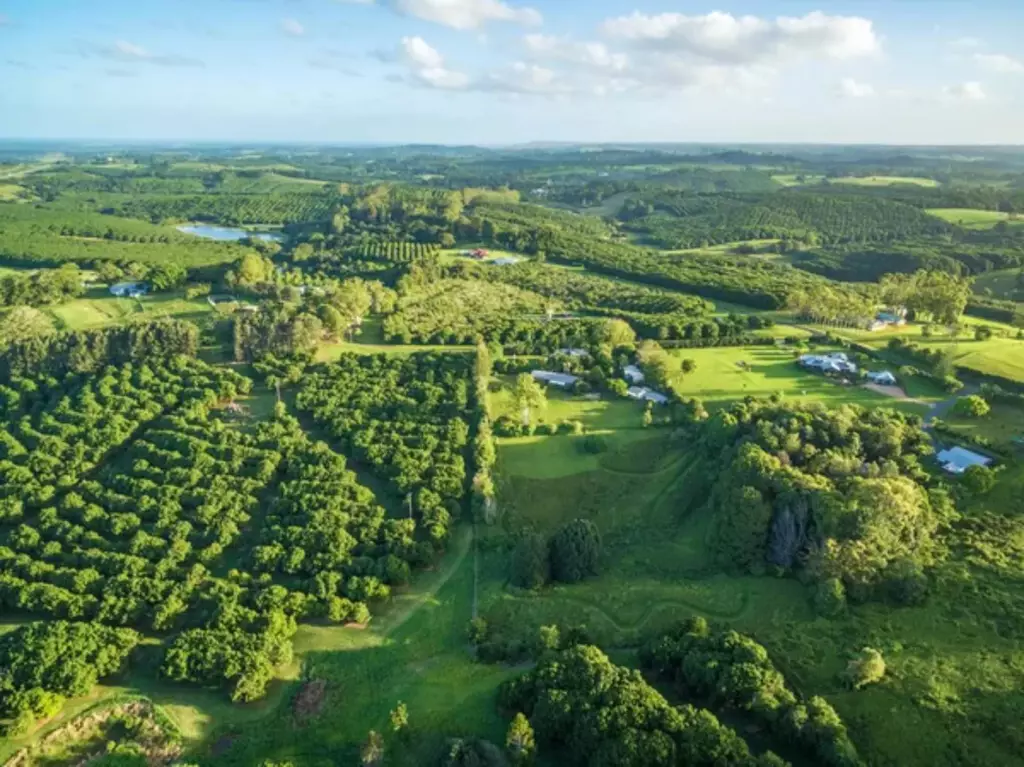
When to prune macadamia trees
Macadamia trees require regular pruning to maintain health and maximize nut production. It is recommended to prune macadamia trees during late winter (February and March) and early spring (March and April).
During the first few years, focus on training your trees to develop a strong framework. Remove dead or overlapping branches to ensure adequate foliage exposure to sunlight, promoting a more fruitful harvest. For a more detailed process of the proper way of pruning, you can follow this guide.
Dealing with non-fruiting macadamia trees
Insufficient pollination is considered a key factor leading to poor nut yields and reduced harvests, which can affect the profitability of macadamia farming.
One major cause of inadequate pollination is the lack of bees, the primary pollinators for these trees, which can be attributed to habitat loss, pesticide use, and diseases impacting bee populations.
To combat these challenges, you can try introducing managed beehives which cost less than you think or promoting native bee populations in orchards to significantly improve pollination efficiency.
Aside from insufficient pollination, other factors that cause reduced to non-production of nuts in macadamias are rounded up in this article.
Importance of pollinators for macadamia trees
While macadamia trees are self-fertile and can produce nuts on their own, cross-pollination significantly benefits them, leading to an abundant yield.
Bees, especially honeybees, are highly efficient pollinators for macadamias due to their foraging behavior and the electrostatic charge that helps pollen adhere to their bodies.
Besides bees, beetles and other insects also contribute to pollination, albeit to a lesser extent. Wind can also aid in pollination, but its effectiveness is minimal compared to insect pollinators.
Check out this article to learn more about factors that affect the success of pollination in macadamia trees.


